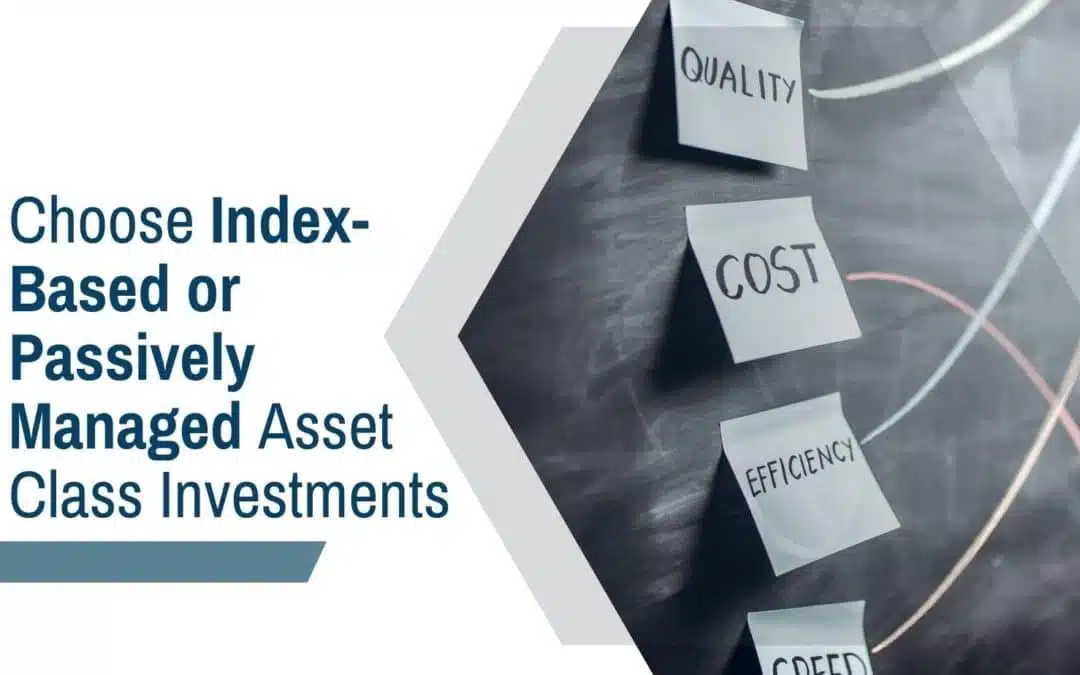the empowered investor
The Investment Policy Statement
The IPS: A Living Document to Set Expectations and Add Accountability
Key Takeaways
-
Your Investment Policy Statement (IPS) is a service agreement between you and your advisor—or between you and yourself, if you’re a Do-It-Yourself type.
-
Your IPS describes your goals, and the steps you and your advisor plan to take to reach them. It also sets transparent, empowering, and accountable expectations about how you’ll implement your investment philosophy.
-
There are no formal requirements on what to look for in an IPS, but we typically include eight components: your personal goals and circumstances, risk tolerance, timelines, cash flow, asset allocations, investment philosophy, risk potentials, and costs.
-
Your IPS is a platform from which to build your financial future, as well as a living reference that grows and evolves through conversations, feedback, and updates.
“Without an Investment Policy Statement to guide the way, you end up getting a bunch of random ideas loaded up in a portfolio”
After covering the cycles of your financial life—including building a strong foundation, planning for your power years, and enjoying your “chill out” time—we’re circling back to where we started this Empowered Investor blog series, to talk about the essentials of having an Investment Policy Statement (IPS).
You may recall, back in our third post, we challenged you to describe your personal investment philosophy in 20 words or less. If you didn’t have one then, we hope it’s beginning to come into focus, inspired by these posts.
However, we’re not done yet. Words are important, but so are deeds! That’s where your IPS comes in, to set expectations and keep everyone accountable for their actions.
WHAT’S AN INVESTMENT POLICY STATEMENT?
Your IPS is a service agreement between you and your advisor (or between you and yourself, if you’re a Do-It-Yourself type). It describes your goals, as well as the steps you and your advisor plan to take to reach them. It also sets transparent and empowering expectations about how you’ll actually implement your investment philosophy, so you and your advisor can hold each other accountable to it over time.
What are your target returns? Exactly how will your portfolio be managed? What will your advisor be doing—and not doing—on your behalf? If you don’t explicitly document these sorts of tangibles, how do you measure whether you’re achieving them? In our related podcast, “The Investment Policy Statement,” Marcelo Taboada provides a host of analogies to help you embrace the idea. For example:
- Blueprints: If you hire an architect to upgrade your home, you certainly expect to see some blueprints before they start tearing down any walls.
- Service agreements: When you sign up for a cell phone service, you want to know how many minutes you’re purchasing at what cost, what happens if you exceed your limit, and so on. Your service agreement tells you all this and more.
- Written planners: If you hire a personal trainer, they’re likely to create a written planner for you, against which you’ll track your progress.
You could compare your IPS to any or all of these similar documents. There are enough uncertainties in life, without leaving something as critical as managing your life’s savings to random chance.
WHAT SHOULD YOUR IPS INCLUDE?
The IPS dates back to at least the 1960s, when pension funds developed them to ensure their service providers were all on the same page about how the funds would be managed. As we see it, if it’s good enough for the biggest and best corporate and government pension plans it’s good enough for us too.
There are no formal requirements on what to look for in your IPS. But following are eight components we typically include in ours.
- Personal financial goals and circumstances. We lead with this one, because it’s so important to first focus on the “why” of investing, before diving into the “how.” Your advisor needs to really listen to you, learn about your goals and circumstances, and put these details into writing to serve as your shared target. Then, the investing can begin.
- Your capacity and willingness to bear investment risks. What will you do if a bear market savages your portfolio? How big a hit can you afford to take? How willing are you to take it in stride if it happens? These two questions may have different answers; combined, they suggest your risk tolerance. It can be a jungle out there for investors. Describing your risk tolerance in your IPS gives us a reference point to revisit when (not if) you’re staring a scary market tiger in the eyes and trying not to blink.
- Investment timelines. How long you have to invest also informs your ability to ride out market downturns. If we don’t define your timelines, we’ve found many investors miscalculate them. For example, even if you retire in your 60s, you won’t need access to all your cash, all at once. Hopefully, some of it will still need to be around when you and/or your spouse are in your mid-to-late 80s or even 90s. You’ll want to build your portfolio accordingly.
- Cash flow. Are you still accumulating wealth in your power years? Are you spending it down as you enjoy your “chill out” years? Either way, by quantifying your incoming and outgoing cash flows in your IPS, you can better ensure your retirement projections and other spending plans are sustainable over the long run.
- Target asset allocations. How you allocate your assets across various slices of the market is at the heart of converting your investment goals into expected long-term returns. We’ll be covering asset allocation in upcoming posts, but here, we’ll point out how critical it is to commit to a prescribed mix at the start. By putting it in writing, it becomes a mutual agreement: Your advisor agrees to keep you invested as described, and you’ll be less tempted to bail on your plans when the going gets rough.
- Investment philosophy. Remember that investment philosophy we mentioned earlier? You and your advisor really need to see eye-to-eye on one, or you’re unlikely to ever be a good fit for each other. At Tulett-Matthews, ours is an evidence-based approach to investing. We’ll discuss what we mean by that in more detail as we roll through the rest of this series. Or, if you’d rather not wait, you can check out chapters 3–6 in our book, The Empowered Investor.
- Greatest potential risks. If you’ve got a solid plan, a strong portfolio, and a decent advisor, what could possibly go wrong? Unfortunately, quite a bit. Like a global pandemic. Or a war in Ukraine. Or a wildfire in British Columbia. Your IPS should include a section that reminds you that risk tradeoffs are very real as you pursue higher returns. With a hat tip to our colleague Rob McClelland for the nifty idea, we take a look down memory lane, sharing how your portfolio might have performed during a handful of the most challenging markets we’ve encountered in the past several decades. We call this our “lifeboat drill”, to help us soberly prepare for what we’ll do together whenever investment risks are realized.
- Costs. You also owe it to yourself to know and understand your investment costs. Fortunately, CRM2 has helped level this playing field. At least after the fact (in an annual report), portfolio managers must now disclose their own fees as well as other costs, such as custodian charges, product fees, sales commissions, etc. Including costs in your IPS should give you and your advisor an additional opportunity to discuss them upfront, to ensure you understand why you’re incurring them, and whether they’re reasonable. For example, we see no reason to ever incur costs for commissions or similar incentives that encourage your advisor to promote one product over another. These “kickbacks” can only benefit those selling the products, not those purchasing them!
THE IPS AS A LIVING DOCUMENT
In our opinion, a detailed IPS should serve as the foundation for any new advisory relationship you enter into … even if it’s with yourself, as your own DIY “advisor”. If your plans are built on vague promises and shiny hopes, it’s too easy for your dreams to crumble the first time they encounter any turbulence. By grounding your financial castle in clear expectations and accountable actions, you and your advisor are better positioned to champion your goals through exciting and challenging times alike.
This does not mean your IPS can’t ever change. Quite the contrary, this document is not only the platform from which you’ll build your financial future, it should become a living reference that grows and evolves over time, remaining relevant to your needs through ongoing conversations, feedback, and updates.
Next up, we’re going to dive into that pivotal question we asked at the beginning: What is your investment philosophy? For us, evidence-based investing is our guiding light. But why, and how? We’ll be using the rest of this series to answer that. In the meantime, if you have questions or comments about what you’ve read so far, please reach out to us today. We love hearing from our readers!
Additional Reading:
- The One-Page Financial Plan, by Carl Richards
- Don’t Fall for It: A Short History of Financial Scams, by Ben Carlson
- And, as always, our own book: The Empowered Investor
More Winning Investment Principals

Investment Principal #4: Maximize Returns with Key Investment Factors
Discover how investment factors can help you maximize returns. Learn strategic factor investing to enhance your portfolio.

Investment Principal #3: Using Passive/Index Funds or ETFs
Index-based or passive asset class funds focus on how to reduce the costs and frictions involved in capturing the market’s generous expected returns over time.

Investment Principal #2: Diversify Your Asset Classes
The magic behind diversification is found in a financial measure known as correlation, or the degree to which two asset classes move in similar patterns.
Stay on top of your financial education
Subcribe and follow to get updates on important wealth management topics.

Connect
Visit Us
3535 St-Charles Blvd.
Suite 703
Kirkland, Quebec
H9H 5B9
Connect